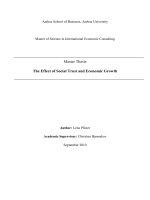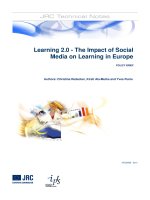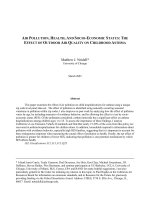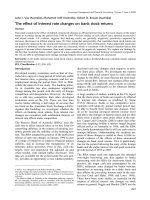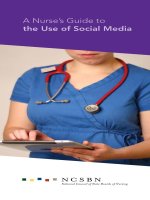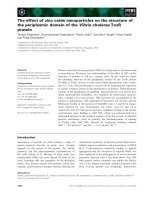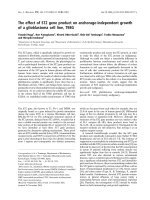The effect of social media advertising on consumers’ intention to purchasing online courses
Bạn đang xem bản rút gọn của tài liệu. Xem và tải ngay bản đầy đủ của tài liệu tại đây (1.33 MB, 99 trang )
MINISTRY OF EDUCATION AND TRAINING
UNIVERSITY OF ECONOMICS HO CHI MINH CITY
HUA PHUONG QUYNH
THE EFFECT OF SOCIAL MEDIA ADVERTISING ON CONSUMERS’
INTENTION TO PURCHASING ONLINE COURSES
ECONOMICS MASTER'S THESIS
Ho Chi Minh City - 2021
MINISTRY OF EDUCATION AND TRAINING
UNIVERSITY OF ECONOMICS HO CHI MINH CITY
HUA PHUONG QUYNH
THE EFFECT OF SOCIAL MEDIA ADVERTISING ON CONSUMERS’
INTENTION TO PURCHASING ONLINE COURSES
Major: Business Administration (Faculty)
Academic Research Direction
Code: 8340101
ECONOMICS MASTER'S THESIS
Instructor: Nguyen Phong Nguyen, Ph.D.
Ho Chi Minh City - 2021
STATEMENT OF AUTHENTICATION
I herewith formally declare that I myself have written the submitted Master’s Thesis
independently. I did not use any outside support except for the quoted literature, and
other sources mentioned at the end of this paper.
Hua Phuong Quynh
TABLE OF CONTENT
ABBREVIATIONS
LIST OF TABLES
LIST OF FIGURES
LIST OF DIAGRAMS
ABSTRACT
CHAPTER 1: INTRODUCTION ............................................................................... 1
1.1. BACKGROUND .............................................................................................. 1
1.2. RESEARCH GAPS .......................................................................................... 3
1.3. RESEARCH QUESTIONS AND OBJECTIVES ............................................ 3
1.4. RESEARCH SCOPE ........................................................................................ 4
1.5. METHODOLOGY ........................................................................................... 4
1.7. OUTLINE OF THE THESIS............................................................................ 5
SUMMARY OF CHAPTER 1 .................................................................................... 7
CHAPTER 2: LITERATURE REVIEW .................................................................... 8
2.1. INTRODUCTION ............................................................................................ 8
2.2. OVERVIEW OF PREVIOUS RELATED RESEARCH ................................. 8
2.3. THEORETICAL BACKGROUND................................................................ 10
2.3.1. Theory of planned behavior (TBP) .......................................................... 10
2.3.2. Advertising model .................................................................................... 11
2.3.3. Flow theory............................................................................................... 12
2.3.4. Social media ............................................................................................. 13
2.3.5. Purchase intention .................................................................................... 13
2.3.6. Online courses .......................................................................................... 14
2.4. HYPOTHESIS AND RESEARCH MODEL ................................................. 14
2.4.1. Flow experience ....................................................................................... 14
2.4.2. Credibility ................................................................................................. 15
2.4.3. Information ............................................................................................... 16
2.4.4. Entertainment ........................................................................................... 17
2.4.5. Interaction ................................................................................................. 17
2.4.6. Irritation .................................................................................................... 18
SUMMARY OF CHAPTER 2 .................................................................................. 20
CHAPTER 3: RESEARCH METHODOLOGY ...................................................... 21
3.1. INTRODUCTION .......................................................................................... 21
3.2. RESEARCH PROCESS ................................................................................. 22
3.3. RESEARCH MODEL .................................................................................... 22
3.4. RESEARCH METHODS ............................................................................... 23
3.4.1. Methods of collecting primary information ............................................. 23
3.4.2. Methods of collecting secondary information .......................................... 23
3.5. RESPONDENTS AND SURVEY SAMPLE SIZE ....................................... 23
3.6 QUESTIONARY DESIGN ............................................................................. 24
3.7. DATA COLLECTION ................................................................................... 26
3.8. CRONBACK’S ALPHA AND EFA .............................................................. 27
3.9 SURVEY DATA ANALYSIS ........................................................................ 27
3.9.1 Descriptive statistical analysis .................................................................. 27
3.9.2 Advanced statistics .................................................................................... 28
SUMMARY OF CHAPTER 3 .................................................................................. 30
CHAPTER 4: RESEARCH RESULTS .................................................................... 31
4.1. INTRODUCTION .......................................................................................... 31
4.2. DESCRIPTIVE STATISTICS........................................................................ 31
4.2.1 Descriptive statistics of the survey subject ............................................... 32
4.2.2 Descriptive statistics and Pearson correlation for the independent variable33
4.3. ADVANCED STATISTICS ........................................................................... 34
4.3.1. Cronbach’s Alpha reliability analysis ...................................................... 34
4.3.2. EFA analysis............................................................................................. 35
4.3.3. Single regression analysis ........................................................................ 36
4.2.4. Results of testing factors effect on purchase intention of online course .. 42
4.2.5. Independent Sample T-test ....................................................................... 44
SUMMARY OF CHAPTER 4 .................................................................................. 46
CHAPTER 5: CONCLUSIONS ............................................................................... 47
5.1. INTRODUCTION .......................................................................................... 47
5.2. CONCLUSION ............................................................................................... 47
5.2.1. Flow experience has a positive impact on purchase intention of online
courses ................................................................................................................ 47
5.2.2. Credibility has a positive impact on purchase intention of online courses48
5.2.3. Information has a positive impact on purchase intention of online courses48
5.2.4. Entertainment has a positive impact on purchase intention of online
courses ................................................................................................................ 48
5.2.5 Interaction has a positive impact on purchase intention of online courses49
5.2.6 Irritation has a positive impact on purchase intention of online courses .. 49
5.2.7 There is no significant difference between male and female about the
affection of social media advertising towards purchase intention of the online
course .................................................................................................................. 49
5.3. RESEARCH IMPLICATIONS ...................................................................... 50
5.4. LIMITATION AND FUTURE RESEARCH................................................. 51
SUMMARY OF CHAPTER 5 .................................................................................. 53
REFERENCES
APPENDIX 1: QUESTIONARIES
APPENDIX 2: DESCRIPTIVE STATISTICS FOR SURVEY SUBJECT
APPENDIX 3: DESCRIPTIVE STATISTICS FOR THE INDEPEPNT
APPENDIX 4: PRELIMINARY TESTING OF CROMBACK’S ALPHA
RELIABILITY
APPENDIX 5: OFFICIAL TESTING OF CROMBACK’S ALPHA RELIABILITY
APPENDIX 6: PRELIMINARY TESTING EFA
APPENDIX 7: OFFICAL TESTING EFA OF INDEPENDENCE
APPENDIX 8: SINGLE REGRESSION
APPENDIX 9: REGRESSION MODEL OF TOWARDS PURCHASING THE
ONLINE COURSE
APPENDIX 10: INDEPENDENT SAMPLES T-TEST
ABBREVIATIONS
TBP: Theory of planned behavior
TRA: Theory of reasons action
EFA: Exploratory factor analysis
LIST OF TABLES
Table 1.1. Classifying classes through the percent of content communicate on the
internet. ........................................................................................................................ 2
Table 3.1. The scale of factors influencing online purchase intention courses
through social media advertising. ............................................................................. 25
Table 4.1 Survey Result ............................................................................................ 31
Table 4.2 Demographics of the participating informants ......................................... 32
Table 4.3 Pearson correlation and mean ................................................................... 34
Table 4.4. Cronbach's Alpha Coefficient .................................................................. 34
Table 4.5. Summary of EFA analysis for six independent factors ........................... 36
Table 4.6 Testing regression of hypothesis H1 ......................................................... 37
Table 4.7 Testing regression of hypothesis H2 ......................................................... 38
Table 4.8 Testing regression of hypothesis H3 ......................................................... 39
Table 4.9 Testing regression of hypothesis H4 ......................................................... 40
Table 4.10 Testing regression of hypothesis H5 ....................................................... 41
Table 4.11 Testing regression of hypothesis H6 ....................................................... 42
Table 4.12. Results of testing factors effect on purchase intention of online course ...
................................................................................................................................... 43
Table 4.13. ANOVA ................................................................................................. 44
Table 4.14. Group Statistics ...................................................................................... 44
Table 4.15. Independent Sample T-test .................................................................... 44
Table 4.16. Summary of hypotheses test results ....................................................... 45
LIST OF FIGURES
Figure 2.1. Propose model ........................................................................................ 19
LIST OF DIAGRAMS
Diagram 3.1 Research process .................................................................................. 22
ABSTRACT
___________________________________________________________________
Nowadays, more and more providers and more people accept online courses in
Vietnam, especially in the COVID-19 period. Based on the TPB theory, flow
theory, and social media adverting model, the thesis determined social media
advertising factors affecting purchasing intention online course of consumers in Ho
Chi Minh City. These factors are credibility, entertainment, information, interaction,
irritation, flow experience, and purchase intention. The survey was conducted in Ho
Chi Minh City, the largest business center in Vietnam. The thesis includes 250
samples through the social media user survey; 210 valid responses were collected.
Thence, businesses can propose social media advertising solutions to enhance
consumers' intention toward purchasing online courses in Ho Chi Minh City.
___________________________________________________________________
Keywords:
social
media,
purchasing
intention,
credibility,
information, irritation, flow experience, interaction, online course.
entertainment,
1
CHAPTER 1
INTRODUCTION
1.1. BACKGROUND
According to the statistical report, internet usage in Vietnam in 2020, there are
68.17 million people using internet services in Vietnam. It has increased by about
6.2 million from 2019 to 2020. Currently, internet usage in Vietnam over the total
Vietnamese population stands at 70%. In the use of social networks in Vietnam in
2020, 65.00 million are using social media for entertainment, contacting friends,
sharing moments, life tips, and even sales advertising. The number of people using
social media in Vietnam has increased rapidly, with a specific increase of 5.7
million from 2019 to 2020. Social media penetration in Vietnam currently stands at
67% (Vnetwork, 2020). Social networks include Youtube, Facebook, Instagram,
Twitter, LinkedIn, and others (Vnetwork, 2019).
Nowadays, with internet growth, many websites, or firms, or schools offer online
courses to meet learners’ needs such as Kyna, Edumall, Topica, Hellochao,
Myclass, and Academy in different fields through social media advertising.
Therefore, people easily search and purchase courses online through social
networks. At the same time, learners are provided the necessary knowledge in the
shortest time.
Covid-19 is currently an important issue, especially regarding education. Online
learning is increasingly popular and accepted by more and more people. To prevent
and avoid covid-19, many schools have had to suspend or switch to e-learning.
Online education has long been a popular concept in the world. E-Learning is
known as a learning revolution, a learning method that brings many benefits and
benefits for learners. Since the 2000s, Internet technology has penetrated deeply in
human life. Almost all classrooms are now using Internet technology and electronic
means to some extent. E-Learning is the use of Web and Internet technologies in
2
learning (Horton, 2001). The content is organized into structured courses using free,
open-source educational platforms such as Moodle, Sakai, and Open edX
(Meikleham & Hugo, 2020).
Table 1.1. Classifying classes through the percent of content communicate on the
internet (Allen & Seaman, 2006)
Content
Group
transmitted via
Class
the internet
classifications
Description
(%)
A
0%
Traditional
All content is communicated directly
classroom
Using
B
1-29%
internet
technology
to
publish
Using the
materials, such as outlines, exercises, and
internet
lessons. Students and teachers meet face to
face
Combination
C
30-79%
(Blended /
Hybrid)
D
80+%
Online
Combination of internet technology and
tradition.
Students
and
teachers
meet,
exchange on the Internet and face-to-face.
All content is on the Internet. There is no
face-to-face.
The thesis’s novelty is the combination between social media advertising model,
flow theory, and theory of planned behavior (TPB) that previous studies have not
shown clearly factors: credibility, entertainment, irritation, information, interaction,
flow experience, and purchase intention. Simultaneously, more and more providers
and more people accept online courses in Vietnam, especially in the COVID-19
period. Consumers can use social networks to understand the course and the
provider. From all of them, the author decided to conduct the research topic: “the
effect of social media advertising on consumers’ intention to purchasing online
courses.”
3
1.2. RESEARCH GAPS
Foreign studies are presented with a complete model than Vietnamese research on
social media advertising's impact on purchase intention. Previous studies in
Vietnam have not shown the effect of experience flow on purchase intention.
Researching the factors that affect purchase intention is a popular topic. However,
researching the factors that affect the intention to buy an online course is a new
topic when society and technology are developing and the COVID-19 period in
2020. Online courses in previous studies often focus on the study of the effects on
the enhancement or interactivity of courses (Shapiro et al., 2017; Yang,D., 2017). In
this topic, the author focuses on researching the factors of social media influencing
the intention of buying online for online courses. Nowadays, online courses are no
longer limited to schools, but educational companies design programs suitable for
different fields to meet the needs of learners. Learners are all people with a need to
improve their knowledge in the field they need. For example: Economics, cooking,
design, ...To fill the above gaps and create novelty for the topic, the author decides
to conduct this study that develops the flow experience variable and tests the model
that shows the impact of social media advertising on the intention to buy an online
course based on the research model of Ngo My Tran & Mai Vo Ngoc Thanh (2017).
1.3. RESEARCH QUESTIONS AND OBJECTIVES
This study has an overall research question: “How does the effect of social media
advertising towards online course purchasing intention in the context of Ho Chi
Minh City during the COVID-19 period.”
This study also has an overall research objective that examines the effect of 6
factors (entertainment, irritation, credibility, interaction, information, flow
experience) towards purchase intention of the online courses.
4
1.4. RESEARCH SCOPE
The object of the research is social media advertising's effect on purchasing
intention of online courses.
Scope of the research: The research sample scope is social network users.
Research space scope: social network users in Ho Chi Minh City
Research content scope: researching social media advertising affects consumers'
intention toward purchasing online courses based on the social media advertising
model, flow theory, and theory of planned behavior (TPB).
1.5. METHODOLOGY
Based on the research objective, the author employs mixed methods, including
qualitative and quantitative techniques. Research starts from the study of previous
documents to develop theoretical research models and includes the following main
work: Qualitative research; Preliminary quantitative research; Formal quantitative
research
Qualitative research is done on the subjects who are using social media. From the
previous studies, the report identifies research gaps and set research objectives. The
author conducted interviews with experts, completed questionnaires, prepared for
qualitative research. Quantitative research was conducted on subjects using social
networks with 250 questionnaires in Ho Chi Minh City. The questionnaire, after
being sent to the surveyor in the form of a link via an email, Zalo or Messenger, the
answer results were synthesized, encoded data entered into excel, then processed by
SPSS software. The total number of answer sheets is sent 250, of which there are 40
invalid answers sheet, 210 valid answers.
1.6. JUSTIFICATION
In the COVID-19 period, countries worldwide try to raise public awareness of
intervention and intervention strategies by providing daily updates on monitoring
5
cases and operations on websites and social media (Gao et al., 2020). Social media
is a task management tool for informational and educational purposes (Kircaburun
et al., 2020). The ready access to and availability of social media has opened up a
wealth of data that marketers leverage for strategic insight and digital marketing
(Jacobson et al., 2020). Social media also plays a critical role in providing online
learning to learners. To prevent the COVID-19 epidemic from affecting learning,
many schools around the world offer online courses. Learning continues, and
learners still receive an essential piece of knowledge for themselves. Video- and
voice-enabled discussion platforms have the potential to increase student
engagement, leading to student success. The cloud-based discussion platform, voice
thread, was used with undergraduate students in an online hospitality facilities
management course (Mejia, 2020). In Vietnam, the online learning program has
also been expanded. Not only for learning but also for exams to ensure students and
students still finish the course on time. This has done very well in Vietnam.
Thereby, we can see the importance of online courses and the correct combination
of social advertising in learning. This study determine the impact of social media
advertising on the intention of purchasing online courses.
1.7. OUTLINE OF THE THESIS
Chapter 1: In this chapter, the author will introduce an overview of the topic, such
as the reason for choosing the topic, the research item, the research object, the scope
of the study, the research method, and the composition of the topic. This is the basis
for orientation of the topic, collecting research data, evaluating data, selecting and
targeting other related issues.
Chapter 2: This chapter mainly searches and summarizes theories related to
purchasing online courses. It systematizes and makes the most appropriate research
hypotheses and research models, a premise for collecting, processing, and analyzing
data in the following chapters.
6
Chapter 3: This chapter provides research papers, specifically about research
methods, from which research progress, the introduction of the research overview
and research sample, how to design questionnaires, and introduction of research
tools to analyze relevant factors such as Frequency, Statistic, Mean, and Cronbach's
Alpha.
Chapter 4: This chapter dissociates social media advertising's impact on customers'
intention to purchase an online course.
Chapter 5: In this chapter, the study will discuss the results in chapter 4 and offer
recommendations, limitations, and future research directions.
7
SUMMARY OF CHAPTER 1
Chapter 1 presents an overview of the current widespread use of social networks
and its importance to human life. The research presented the needs of online
learning and its concepts. The COVID-19 epidemic happening has made research
more meaningful not only in terms of science but also in practice. The study
presents gaps of previous studies and model selection of Ngo My Tran and Mai Vo
Ngoc Thanh (2017) to develop additional flow experience to the model that shows
the impact of social media advertising on the intention to buy an online course.
Through the research question: “How does the effect of social media advertising
toward online course purchasing intention in the context of Ho Chi Minh City
during the COVID-19 period.” The study scope is limited to those who use social
networks in Ho Chi Minh City. Research is done through quantitative and
qualitative methods. The author introduces an overview of the research structure so
that readers can have an overview of the research.
8
CHAPTER 2
LITERATURE REVIEW
2.1. INTRODUCTION
In chapter 2, section 2.2 has reviewed previous studies in the country and the world.
Inheriting and promoting the advantages of previous studies as well as overcoming
and expanding research from previous studies. Then, section 2.3 has presented the
basic theoretical concepts: Theory of planned behavior (TBP), advertising model,
social media advertising, flow theory. Section 2.4
discusses the factors and
hypotheses for the research model from the previous studies and the background
theories.
The
model
factors
include
credibility,
information,
irritation,
entertainment, flow experience, and online course purchase intention.
2.2. OVERVIEW OF PREVIOUS RELATED RESEARCH
Previous studies have been conducted to explore the impact between social media
advertising, flow experience, and purchase intention of the customers (e.g., Y.J.
Kim & Han, 2014; Hamouda, 2018; Hsu, 2020; Hsu et al., 2017; Ngo My Tran &
Mai Vo Ngoc Thanh, 2017). Kim and Han in 2014 with the topic “Why smartphone
advertising attracts customers: A model of Web advertising, flow, and
personalization.” According to the study in the first quarter of the year 2013,
smartphone usage in the US was 35% and more than 73% in Korea. That showed
that the number of people using smart electricity is increasing enormously.
Meanwhile, smartphone advertising had been strongly expanded by businesses. The
study combined the advertising model, personalization, and flow theory. Research
showed that personalization positively impacted the informativeness, credibility,
and entertainment of advertising messages and negatively affected Irritation. The
advertising value and flow experience increased the customer's buying intent.
Advertising values had a positive impact on reliability, entertainment, and
incentives. The flow experience positively impacted prestige, entertainment, and
9
incentives. Irritation negatively affects the flow experience (Y. J. Kim & Han,
2014).
Topic “Understanding social media advertising effect on consumers’ responses: an
empirical investigation of tourism advertising on Facebook” was researched by
Manel Hamouda in 2018. The author used Ducoffe’s advertising value model to
examine the affection of advertising value on consumers’ attitudes and behavior in
tourism advertising on Facebook. Conducting was on a quota sample of 352
Facebook users in Tunisia. Results show that there is a significant affection between
information, entertainment, credibility, and social media advertising value. This will
influence customers' favorable attitude toward social media advertising and their
behavioral responses (Hamouda, 2018).
The topic “How vloggers embrace their viewers: Focusing on the roles of parasocial
interactions and flow experience” was studied by Chia-Lun Hus in 2020. Social
media allowed marketers to influence consumers directly through a wide range of
tools. Characterization of individual platforms allows the development of
innovative and innovative strategies for social media marketing. This study aims to
examine social interactions (PSI) and their consequences. The intermediate role of
runoff experience was also examined in this study. Results, implications, and
further research directions were also presented in this study (Chia-Lin Hsu, 2020).
In Taiwan, the study of Hsu et al. (2017) showed that the flow experience mediates
social shopping behavior, including factors: user beliefs, website quality, flow
experience, and social shopping behavior. The author surveyed 386 people in
Taiwan to examine the relationship between factors. The results showed that the
flow experience has an intermediate effect on social shopping behavior. It also
showed a significant correlation between user trust, website quality, and streaming
experience. Research showed the positive impact of flow experience on social
shopping behavior by increasing the influence of both site quality and user trust
(Hsu et al., 2017).
10
In 2017, Ngo My Tran & Mai Vo Ngoc Thanh with the topic: “Social media
marketing effect on consumers’ shopping intention in Can Tho.” The topic's goal is
to analyze the impact of social media advertising on consumers' shopping intentions
in Can Tho. The project collected data from 193 consumers in Can Tho. Two main
analytical methods are used in the thesis are the exploratory factor analysis method
and multiple linear regression analysis. Research results showed that there are four
factors of social media advertising influencing consumers' shopping intentions.
Among them, social interactivity, entertainment, credibility, and permission
positively impacted consumers' purchasing intention. In contrast, irritation hurts the
purchasing intention of the customer. Based on the research results, some
recommendations were proposed to help businesses improve social media
advertising effectiveness (Ngo My Tran & Mai Vo Ngoc Thanh, 2017).
2.3. THEORETICAL BACKGROUND
2.3.1. Theory of planned behavior (TBP)
TBP is the development and refinement of TRA (Theory of Reasons Action). TRA
is one of the first and most pioneering theories in consumer behavior psychology
(Ajzen & Fishbein, 1975). According to this theory, behavior intention determines
the customer's behavior. So we only need to study the behavior intention instead of
behavior. Accordingly, behavior intention is influenced by two factors: attitudes and
subjective norms. The attitudes are measured by the trust of customers about the
product attributes. Meanwhile, subjective norms are affected by the reference group.
TBP stems from the limits of human behavior that have little control. TBP shows a
relationship between beliefs and behavior (Ajzen, 1991). TBP includes attitudes,
subjective norms, and perceived behavioral control that clarify humans' intentions
and behaviors (Ajzen, 2005). TPB has been widely accepted and used in studies to
predict specific user intent and behavior of individuals. Moreover, empirical studies
have shown the relevance of this model in studying consumer behavior in the online
11
shopping context. In both the TRA and TPB models, the results show that the TPB
model explains customer behavior better than the model TRA (Hansen et al., 2004).
Moreover, in the context of Vietnam research, several studies have shown that TPB
is more suitable in predicting consumer online shopping intentions.
Besides the above three factors, trust is one factor that significantly influences
consumers' intention to buy online. Lack of trust has been reported to be one of the
main reasons consumers are prevented from shopping online (Jarvenpaa et al.,
2000; Lee et al., 2001). If trust is not built, online transactions cannot happen
(Winch & Joyce, 2006). Therefore, online sellers' customer trust is the basis for
online shopping to occur (Chen & Chou, 2012). In the online shopping landscape,
trust plays a significant role because, in the online environment, consumers'
perception of risks in transactions is higher. After all, buyers are not in direct
contact with people who sell and the product they intend to buy (Jarvenpaa et al.,
2000). The risks that consumers may encounter when shopping online include
financial risks and product risks (Bhatnagar et al., 2000). Perceived risk is a factor
that negatively affects buy intentions online (Chang & Chen, 2008). However,
Gefen et al. (2003) argued that this factor has no direct relationship with intention to
buy online (Gefen et al., 2003).
Based on TBP, the author studies factors that influence the intention to buy online
courses through social network advertising. Factors will show that theory and
reality directly impact attitudes and intention. When people have demands for
products, they will intend to buy. However, the needs depend on many different
factors. Therefore, research needs to find what factors will directly affect general
and social media advertising intention.
2.3.2. Advertising model
Ducoffe’s advertising model showed advertising value, attitude toward advertising,
and three factors: information, entertainment, and irritation that were shown
(Ducoffe, 1996). The factor of credibility was added to the web advertising model.
12
Credibility is shown to be directly related to both advertising value and attitude
toward advertising. With this model, the website's advertising programs, which are
considered high value, will create a positive attitude of consumers and contra.
Entertainment, information of advertisement, and credibility positively impact
attitudes, while irritation negatively affects consumer attitudes (Brackett & Carr,
2001). This is because the attitudes of consumers or an individual towards any form
of advertising are also affected by the attitude towards advertising in general (Lutz,
MacKenzie, & Belch, 1983). Therefore, the author has based on the advertising
model to find the factors that directly affect consumers' attitudes and purchase
intention in this research.
2.3.3. Flow theory
Flow is defined as the psychology of optimal experience(Csikszentmihalyi, 1975).
It is used to describe online interest behavior (Hsu et al., 2012; Webster et al.,
1993). People are immersed in online experiences (Gao & Bai, 2014). Flow
experience is considered to be a source of engaging experiences (Ding et al., 2010).
Flow experience is when people participate in an activity that seems like nothing
else of importance. The experience itself is so enjoyable that people will do it even
at great expense, for the absolute benefit (Csikszentmihalyi, 1990). In other words,
flow experience is when a person is completely immersed in an activity. The person
is fully involved and engaged, and he or she exhibits full enjoyment in the process
(Leung, 2020). A person experiencing flow may have time bias. There is no time
pressure in a responsive activity (Chou & Ting, 2003). Enjoyment in an activity
increases the desire to repeat the activity (Webster et al., 1993). Online behavior
and flow experience are strongly linked (Lee et al., 2018). Online shoppers who do
not pay attention to the website's content will not pay attention to the products.
Additionally, research shows that threading experience is positively and
significantly associated with lucrative purchases (Hsu et al., 2012).
13
Based on the theory of planned behavior, advertising model, flow theory, and
related research, it is possible to see that advertising channels via social media will
indirectly affect consumers' intentions, indirectly through their attitudes toward
advertisements for such products or services. Therefore, the author does not do a
repeat study but analyzes the direct influence of elements of the social network
advertising channel on consumers' intention to buy online courses in Ho Chi Minh
City, based on modifying, supplement and focus on analyzing the impact of the
following six factors on consumers' intention to buy online courses: Flow
experience, credibility, information, entertainment, interaction, and irritation.
2.3.4. Social media
On social media, people can share their ideas and comments on the same problem.
Businesses are already using social media to advertise their products. Social media
advertising plays a crucial role in branding and determining customers' behavior
and intention (A. J. Kim & Ko, 2010). Social media advertising is the form that we
use the social media system to market, advertise, sell online, promote products,
brands, answer questions. Social media's difference is the contents, groups of
customers, and websites be created by the internet users themselves, not only from
the services providers. Social media helps to find and build relationships with
customers, enhancing firms' brand image (Mir, 2012).
2.3.5. Purchase intention
The intention is a factor used to evaluate the ability to perform a behavior in the
future. According to Ajzen (1991), the intention is a motivational factor; it
motivates an individual to perform acts (Ajzen, 1991). Therefore, Delafrooz et al.
(2011) stated that “the intention to shop online is the certain ability of consumers to
make purchases over the Internet” (Delafrooz et al., 2011). Purchase intention is the
process that a consumer develops a genuine readiness for a product or brand (Dodds
et al., 1991; Wells et al., 2011). Purchase intention is a fundamental and vital
14
variable representing a change in customers' future behavior (Whan Park et al.,
2010). Over time, consumers will be able to not only navigate and find interesting
information. It better evaluates the accuracy and usefulness of information found,
building a responsible consumer society, and more objectively (Gil-Saura et al.,
2020).
2.3.6. Online courses
Online Course is the transmission of learning content using modern electronic tools
such as computers, computer networks, satellite networks, internet, and intranet.
The learning content can be obtained from websites, CDs, videotapes, audio via
computers, or television. Teachers and learners can communicate with each other
via the Internet in forms such as e-mail, online discussion, forums, and video
seminars. Courses with a high score positive impact of product rating and producer
popularity on sales will also be high (Zhang et al., 2020). Topics conducted surveys
for all online courses that were compiled and marketed by companies. Courses are
no longer just within the scope offered by the school. Courses are open to people of
all ages and with the need to increase knowledge or expertise in all areas.
2.4. HYPOTHESIS AND RESEARCH MODEL
2.4.1. Flow experience
The consequences of customers' flow experience are intended to use the Web
(Agarwal & Karahanna, 2000), revisit the internet (Luna et al., 2002). The flow
experience of customers positively influences online purchase intentions (Luna et
al., 2002). Furthermore, the flow experience appeared to prolong Internet and
website use (Nel et al., 1999; Rettie, 2001). The flow experience is positively
impacting the intention to play an online game (Chin-Lung Hsu & Lu, 2004). The
flow experience affects behavioral intention, such as an increase in the likelihood of
purchasing from a website (Korzaan, 2003). According to (J. J. Wu & Chang,
2005), the flow experience can increase the transaction intentions of members when
